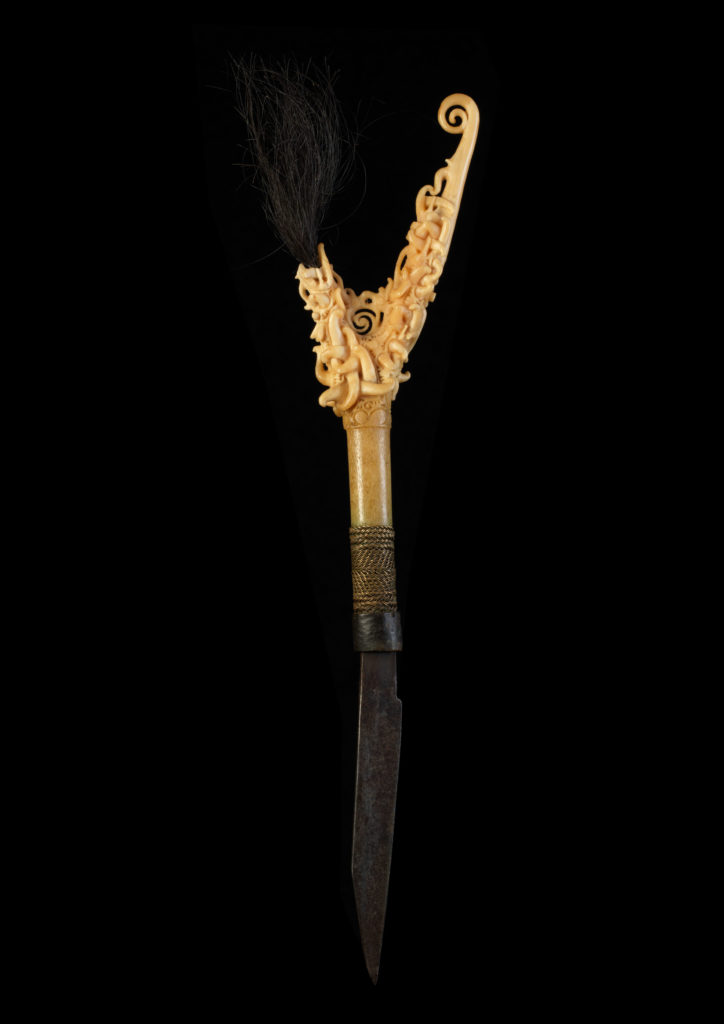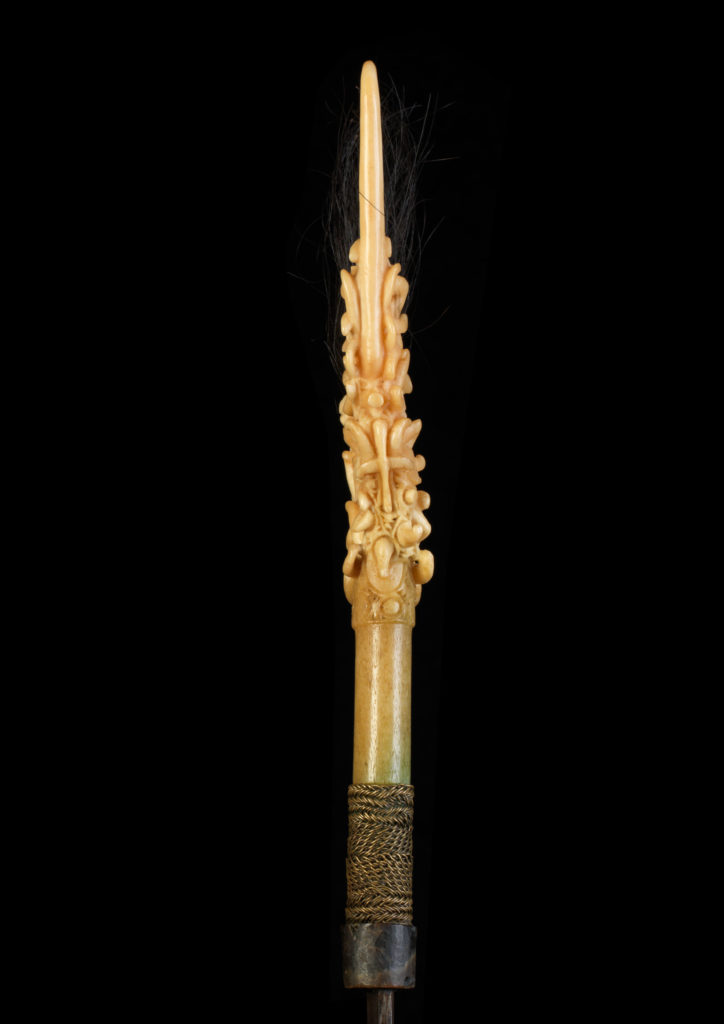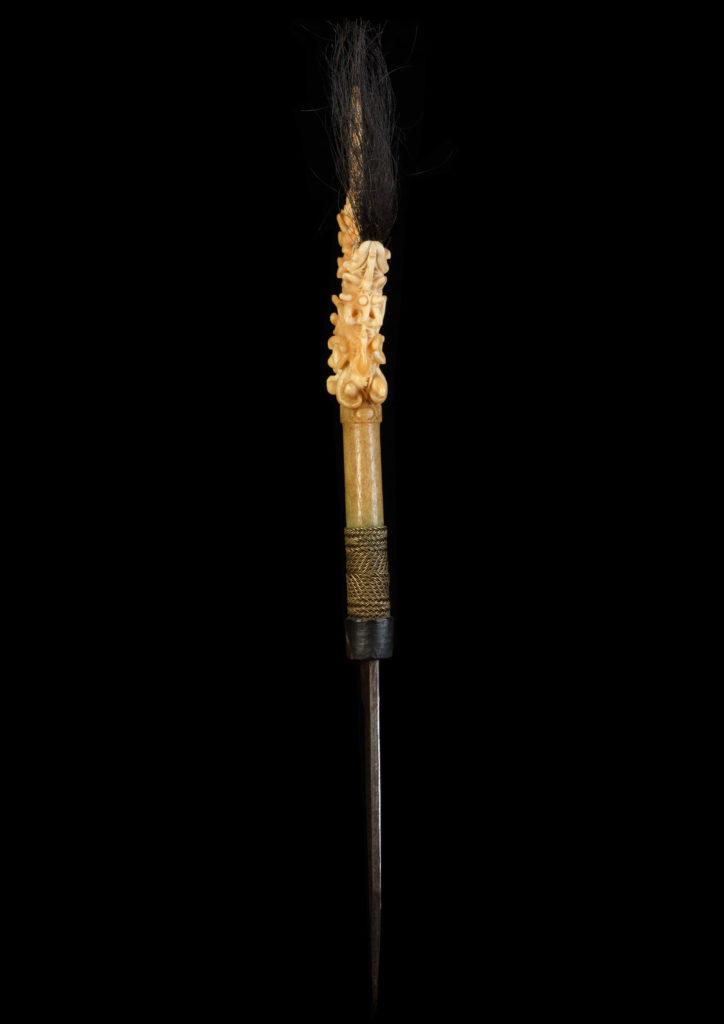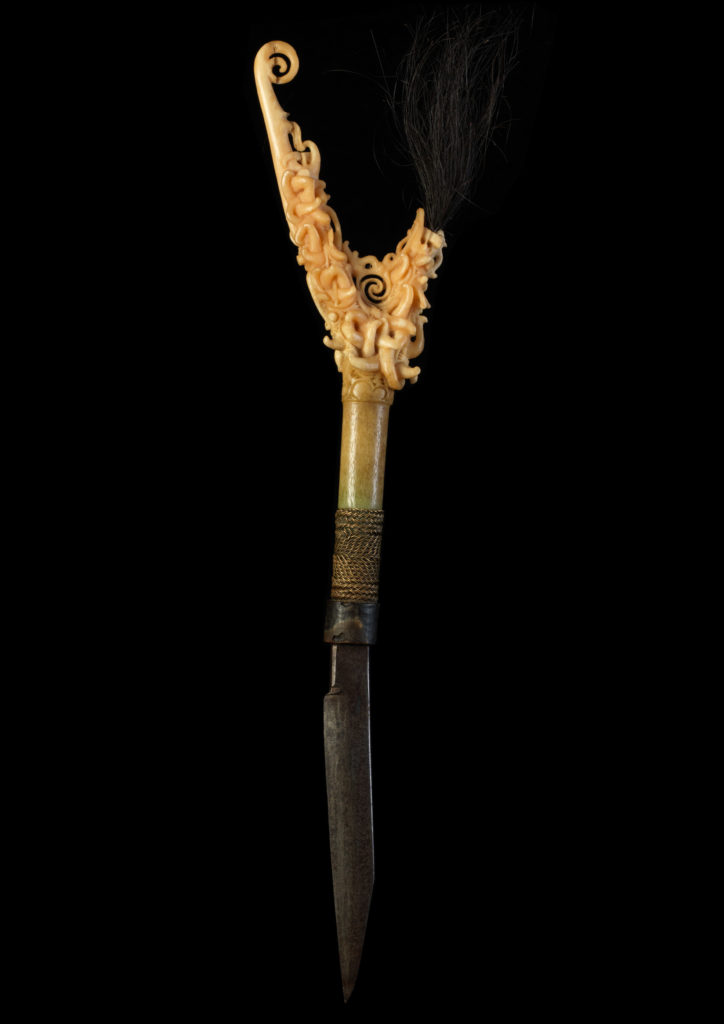Ritual knife “tempesing”
The handle of this extraordinary knife (tempesing or lunggai, literally “feather”) can be considered a textbook example of Kenyah carving at the highest level. A selected piece of forked Sambar stag antlers was used, which in this case has practically no porous core. The whole structure is grouped around the central open-worked double spiral, which embodies the soul’s or hereafter’s journey and the ability of the warrior and headhunter to rededicate life energy. Above the spiral, the aso, the dragon embodying the underworld, is recognised as the recipient of the souls and moderator of the headhunting. The two main arms of the handle that surround him are literally lost in a tangle of almost vivid-looking, protruding leech groups (lemetak) – morphologically probably originally parts of the aso (dragon) body, but in the course of time detached and reinterpreted into independent motif groups. Leeches are said to catalyse head hunting through their affinity to blood or blood taking (Heppell 2005: 124 ff.). However, this interpretation is questionable and not mentioned in early sources. More likely is a free reinterpretation of parts of the dragon and taotie (tiger masks, totem motifs of powerful tribes of the ancient Chinese Zhou dynasty) motifs, which, originally still coming from China, was done in the course of the many centuries after the Dayak (literally “the come”) migrated to Borneo. A comparison with Han and Zhou art clearly shows this; the mythical creatures have powerful fangs and claws, which have become more and more extreme over time as ominous elements. Like other ancient Austronesians, the Dayak are at least partly descendants of southwest Chinese peoples who migrated increasingly to Southeast Asia during and after the collapse of the Han Dynasty.
In some places, this handle shows that bent elements can be seen between the “leeches”, which can be traced back to limbs either of the aso or of the human forms that fell to the aso dragon. Similar to the teeth and claws of the mythical creatures, the limbs have been removed from their original context and regrouped as individual elements. At the base of the handle, small circular shapes can be recognised, which are probably a subtle hint of the head or skull motif. The original winding of the handle is lost. The brass wire netting in the lower part of the handle suggests Kenyah or perhaps Iban work. The fact that the lunggai or tempesing, the side knife of the mandau, was more highly valued than the mandau itself, as circulated in some ancient sources, is completely unfounded. It is also not proven that the knives were mainly used to “clean” the heads taken or to cut the jaw muscles to avoid curses from the separated head.These were everyday tools and above all carving tools, often the only ones available, which makes the immense quality of some of the work on the handles even more astonishing. In the vast majority of cases observed, the knives are less elaborately designed than the mandau. It is more probable that they had a similar status to the mandau itself, mainly because of their functional proximity to (rice) harvesting knives, as the cutting of ears, which was always done individually, or even the cutting of fruit was often equated with the “cutting” of heads.
The question arises as to the purpose of the knife, as it cannot have been carried on the sheath of the mandau in the usual way – the shape is unsuitable for this. There are several possibilities to consider. The knife may have been intended for harvest rituals or the ritualized cutting of the first ears of grain. However, the very strong emphasis on the life cycle in the ornamental groups of the handle, especially the central spiral, suggests a context with the rites de passage (birth, initiation, death). The donation of such knives between nobles is in context with fertility and the continuation of genealogies. There is a continuous mysterious connection between blades and new-born children in the Dayak. The Iban believe that the god Selempandai, the “divine smith”, forges the souls of the children and hardens them in his water trough – only then is conception possible (Sather 1988: 74). Very well possible is also a use by the shaman in the context of rituals (pelian), which should protect the mother-to-be from disaster and miscarriages. One of these rituals is “shielding”, which is performed between the third and fifth month of pregnancy. The translation of pelian jereki roughly means “the erection of a fence” (Sandin, 1978: 58). This involves erecting a symbolic fence of woven mats on the gallery of the nave. Especially in case of nightmares of the mother and close relatives, shielding measures (belimbu ayu) are necessary, in which water is also thrown onto the surrounding mats with a blade. The protective deity of these shamanic practices is Raja Menjaya, the patron saint of shamans and healers. Special blades are used to combat malevolent spirits, as iron is generally considered apotropaic. The same measures are known to be used by the Batak on Sumatra and the Paiwan on Formosa. Less likely, however, is its use for cutting the umbilical cord at the birth of a nobleman; usually a bamboo stake or silver leaf was used for this purpose; more rarely an iron knife (Sandin 1980: 64).
The knife was probably intended as a wedding present or, in the case of a clan alliance, as a gift between high-ranking families, and embodies the desire for trouble-free birth and healthy offspring.
| Object | Ritual knife,”nyu”, “lunggai”, “tempesing” |
| Culture | West-Borneo, Sarawak or Kalimantan, Kenyah (possibly Iban), late 19th century |
| Time | Late 19th / early 20th century |
| Dimensions | Length 35 cm |
| Material | Steel, stag horn, rattan, hair |







